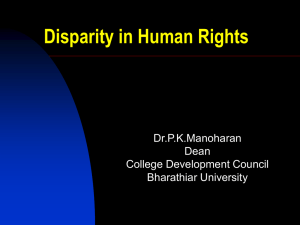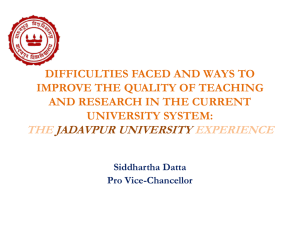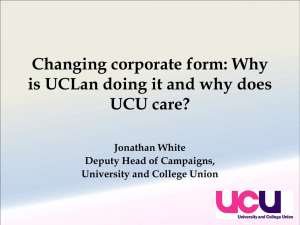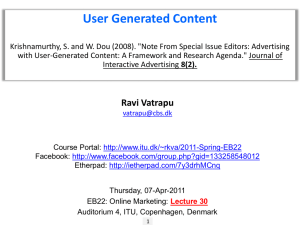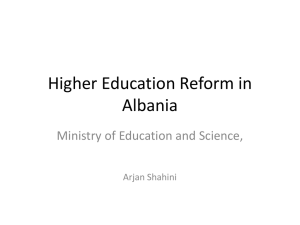Higher Education Mgmt
advertisement
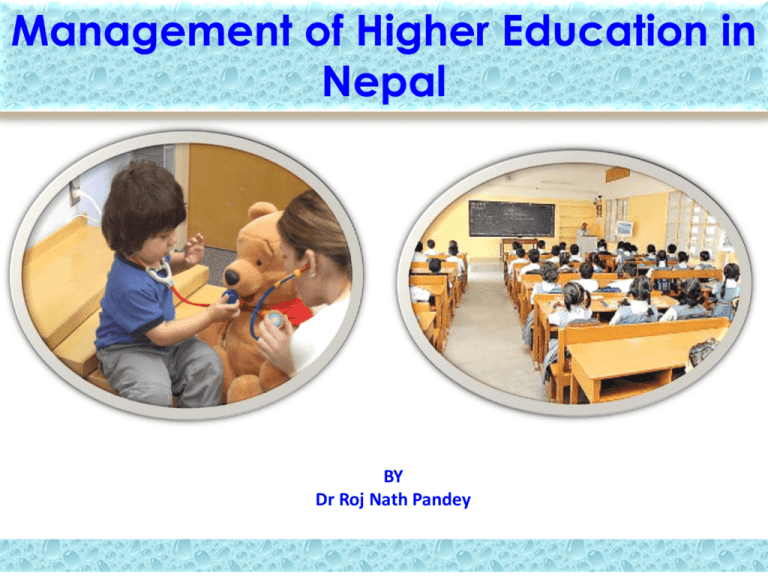
Management of Higher Education in Nepal BY Dr Roj Nath Pandey Think When you hear about management of higher education, what do you think we will address in this session? 2 Ink Write your response. 3 pair Discuss it with the person next to you. 4 Share Share it with the larger group. 5 2nd Millennium Living A Job Focus on time Avoid stress Focus on problems ‘Nice’ culture One-way learning 3rd Millennium Living Work Focus on energy Seek stress Focus on solutions Demanding culture Two-way / three-way/ Multi-way ....learning Knowledge Economy • “Knowledge Economy” the agenda of vision 2020. • A paradigm shift in defining knowledge from the content ‘what’ to the process ‘how’ • A new area of Public Private Partnership in Nepal Emerging Knowledge economy Knowledge Capital Knowledge Capital Pre -industrial era Labour Industrial era Labour Capital The « knowledge economy » Knowledge Labour Knowledge Economy • Is in emerging stages. • reach maturity from 2010 onwards. • China is adding 1500 universities in the year 2011 and india opened door for private universities • A doubling of the world’s knowledge (Bontis, 2002): 1930 every 30 years 1970 every 7 years 2010 every 11 hours • It is difficult to imagine what it will be like when the knowledge economy is in its prime... ‘Knowledge’ Societies No longer rely on the exploitation of natural resources. KNOWLEDGE is the key resource for economic development. Knowledge is a process, not a ‘thing’ does things happens in teams, not in individual ‘experts’ can’t be ‘codified’ into ‘disciplines’ develops on an as-and-when needed basis develops to be replaced, not stored. LEARNING involves generating knowledge not storing it is primarily a group - not an individual - activity happens in ‘real world’, problem-based contexts should be ‘just-in-time’, not ‘just-in-case’ MINDS are not ‘containers’ or ‘filing cabinets’- to STORE knowledge ‘just in case’: they are RESOURCES that can be CONNECTED to other resources in order to GENERATE NEW KNOWLEDGE New Economy Equation Knowledge = money People = knowledge ………. People = What are people demanding today? to go beyond mastering existing knowledge to be able to do things with knowledge (once they have it) Ultimate Solution is Innovation The ability to take elements from one knowledge system put them together with elements from another knowledge system re-arrange these elements to do something new… An Innovation Story From Japan One of the most memorable case studies on Japanese management was the case of the empty soap box, which happened in one of Japan's biggest cosmetics companies. The company received a complaint that a consumer had bought a soap box that was empty. Immediately the authorities isolated the problem to the assembly line, which transported all the package! The boxes of soap to the delivery department. For some reason, one soap box went through the assembly line empty. Management asked its engineers to solve the problem. The engineers worked hard to devise an X-ray machine with high-resolution monitors manned by two people to watch all the soap boxes that passed through the line to make sure they were not empty. No doubt, they worked hard and they worked fast but they spent a whoopee amount to do so. But when a rank-and-file employee in a small company was posed with the same problem, he did not get into complications of X-rays, etc., but instead came out with another solution. He bought a strong industrial electric fan and pointed it at the assembly line. He switched the fan on, and as each soap box passed the fan, it simply blew the empty boxes out of the line. Some Innovations 1 More Innovations 2 Paradigm Shift in Education Beyond constructivism? Past Present Knowledge Adoption Knowledge Production learn = study learn = research rote learning active and productive learning behaviourism constructivism Future Knowledge Na learn = evaluate navigating, evaulatin problem solving and c navigationism / ev social constructivism teaching / instruction learning facilitation mentoring and guided research / supported inquiry The teacher is the primary source of knowledge [source of The teacher is one of the sources of knowledge [source of the WHAT The teacher is the sou competencies required the WHAT] and assisting with the HOW] [source of the HOW] Knowledge creation is for some elites and knowledge is already in place Knowledge creation is the central issue The focus of learning is on gaining The focus of learning is on creating Knowledge creation is issue. The central issu to navigate within the e knowledge explosion The focus of learning i Beyond constructivism? Paradigm Shift in Education Past Present Knowledge Adoption Knowledge Production learn = study learn = research rote learning active and productive learning behaviourism constructivism Knowledge Na learn = evaluate navigating, evaulatin problem solving and c navigationism / ev social constructivism teaching / instruction learning facilitation mentoring and c guided research / supported inquiry The teacher is the primary source of knowledge [source of the WHAT] The teacher is one of the sources of knowledge [source of the WHAT and assisting with the HOW] Knowledge creation is for some elites and knowledge is already in place Knowledge creation is the central issue The focus of learning is on gaining The focus of learning is on creating ? ? Future The teacher is the sou competencies required [source of the HOW] Knowledge creation is issue. The central issu to navigate within the e knowledge explosion The focus of learning is Beyond constructivism? Paradigm Shift in Education Past Present Future Knowledge Adoption Knowledge Production Knowledge Navigation learn = study learn = research learn = evaluate / navigate rote learning active and productive learning navigating, evaulating, integrating, problem solving and communicating behaviourism constructivism navigationism / evaluationism social constructivism teaching / instruction learning facilitation mentoring and coaching guided research / supported inquiry The teacher is the primary source of knowledge [source of the WHAT] The teacher is one of the sources of knowledge [source of the WHAT and assisting with the HOW] Knowledge creation is for some elites and knowledge is already in place Knowledge creation is the central issue The focus of learning is on gaining The focus of learning is on creating The teacher is the source of skills and competencies required to navigate [source of the HOW] Knowledge creation is a side/implied issue. The central issue is to be able to navigate within the enormous knowledge explosion The focus of learning is on navigating Old media and delivery technologies against the new 0 Writing Interactive computers 1400s Paper Local drives & discs 1400s Printing WIMP interfaces 1500s Published books Internet 1600s Indexes, paragraphs Multimedia 1700s Pamphlets Worldwide Web 1800s Photos, sound, film Laptops 1800s Postal services Email 1900s Libraries Search engines 1900s Bibliographies Broadband 1940s Television, phones 3G mobiles 1950s Paperbacks Blogs 1970s 1980s 1990s 2000s 30 years 25 Global Challenges So on……………………………… PANCHASHEEL of New Millennium Learner centred education, Women centred family, Human centred development, Knowledge centred society, and Innovation centred Nepal HE Centres of Excellence (Source: UGC, 2009) v 28 Education 3.0 - a Paradigm Shift Achieved in Holistic Transformation Interdisciplinary Pedagogy Education 3.0 Education 2.0 21st Century Learning Education 1.0 Traditional Education Systems Curriculum 21st Century Skills Enabled by Technology Teachers Accountability Leadership Supported Through an Adapted Reform Agenda Nepalese System of Higher Education TU the largest HE provider 9 Universities in place 3 deemed universities More universities in pipe line 1000+ Colleges Nepalese System of Higher Education…. • Programs of Education – Diploma (3years) – Undergraduate (3 to 5 and ½ Years) – Postgraduate (1 to 2 years) – MPhil (1.5 years) – Doctoral (2 to 5 years) Nepalese System of Higher Education.. • University System – Single Faculty – Multi faculty – Teaching – Affiliating – Teaching cum Affiliating – Single Campus – Multiple Campus Nepalese System of Higher Education.. • • • • Open University Initiative Autonomous Colleges Full fledged Universities Deemed Universities Nepalese System of Higher Education… • Trust or Society • Not for Profit • Degree to be awarded by – University – Deemed University – Institutes Created by Foreign Universities Statutory/Regulatory Bodies • • • • • • • • • University Grants Commission Medical Council Nursing Council Engineering Council Health research council Ayurveda Council Agricultural and veterinary councils CTEVT Pharmacy Council Nepalese System of Higher Education… • Government Funding limited • Private Participation • Exponential Growth in IT and Management Institutions • Decline in Arts & Science Institutions • Sudden rise and decline of some programs like RD, Computer science, sociology, etc. Nepalese System of Higher Education… • Admission through – Merit at the 10+2 level – Entrance Test • Fee Fixation – Almost no Autonomy – Fixed by the Government even for self financed Institutions Nepalese System of Higher Education… • Model of Governance – Decided by the Act/Rules/MOU – Model MOU/Rules as prescribed by UGC – Minimum Standards of Education • UGC • Statutory Bodies (Councils) • Permission to start an Institution by – UGC – Statutory Body HEMIS System Questionnaire Form MOE / National Planning School College College School College Donors Via online College College College Questionnaire Form University Entry and Processing data Send CD UGC Central Database & Processing Reports Stakeholders Transmitting system of satellite and computer-based network Digital Transmission server Sat. Receiver IP/VBI Sat. Receiver IP/VBI Information at University College Data entry ISDN、ADSL Distance Information Platform Fiber / TV VBI Media Fiber UGC PSTN、ISDN、ADSL Reporting (EMIS) system HSE data General Edu. Tech. Edu. UGC Database Produce Annual Progress Report Compile & Summarize Dissemination of Reports Universities Feedback Forward Faculty/Departments Other Institutions Progress Report on each Centre Constituent / Community Campus NEW DEVELOPMENTS Multi-university concept in Nepal opens up wider opportunities for advanced level teaching learning The market gets confused on equivalency and validity of a number of academic programs offered in the country by national as well as international universities The situation demands for the implementation of accreditation system in the country PREVAILING PROBLEMS Due to absence of national assessment and accreditation mechanism, the educational institutions have been using unethical means to claim their academic programs as the best; it has created confusion among the people. Due to absence of proper monitoring and control system, the higher education institutions have hardly maintained minimum infrastructure and human resource base to promote quality education. The graduates hardly have any opportunity to take inter-university transfers of their studies within he country. Some Recent surveys MPhil Masters 60000 50000 40000 2063 30000 2064 20000 2065 10000 0 Technical 400 350 300 250 200 150 100 50 0 250 200 Technical General 2063 2064 2065 Technical 2726 3476 3226 General 33579 38926 52398 150 Technical 100 General 50 0 2063 General PhD 2064 2063 Technical General 2063 2065 2064 2064 2065 2065 2063 2064 2065 106 108 55 183 205 179 14 24 11 176 246 365 Technical General Large number of graduates enrollment in general M Phil rapid grow due to new programs added Decline in PhD is due to introducing of MPhil MPhil is in KU, TU and PokU Female Enrollment (Percentage) 65.00 60.00 55.00 50.00 45.00 40.00 35.00 30.00 25.00 20.00 15.00 10.00 5.00 0.00 Year 2052 Civil 2053 Architecture 2054 2055 2056 Electrical 2057 2058 Electronics 2059 2060 Computer 2061 2062 Mechanical Female Enrollment (Percentage) Trend at Pulchowk Campus for Bachelor Level Enrollm ent Enrollment Students at IOE, T.U. 750 700 650 600 550 500 450 400 350 300 250 200 150 100 50 0 2052 2053 2054 2055 2056 2057 2058 2059 2060 2061 2062 Year Diploma B.E. M.Sc. Ph.D. S&T Institutions Sector wise status of publication of S&T journal S&T Human Resources Human resources by academic qualification S&T Human Resources Decade wise PhD Personnel in of S&T S&T Human Resources PhD Personnel by gender and ethnic group SN 1 Ethnic group Madheshi Number of PhD Personnel Genderwise distribution of PhD personnel in S&T Male Female 129 90.4% 2 Janajati 358 3 Dalit 4 Others 570 Total 1066 9 9.58% Investment in S&T Sector wise funding source of R&D institutions Governance in Higher Education Institutions • HEIs must show that – They are responding appropriately for the needs of the Society – Public Funds are being used responsibly – They must maintain standards of excellence in teaching & research • They should redistribute among stakeholders – Responsibility – Accountability and – Decision Making Powers Coordination/Control Mechanisms • External Regulations – Authority of the Government to lay down rules of operation • External Guidance – Steering power & coordination by external stake holders as members of HEIs Bodies Coordination/Control Mechanisms • External Regulations – Authority of the Government (to lay down rules of operation • External Guidance – Steering power & coordination by external stake holders as members of HEIs Bodies Coordination/Control Mechanisms • Managerial Self Governance – Senior leadership & Management staff who set goals and take decisions on the direction, behavior and activities of HEIs • Academic Self Governance – Governance through consensus among academic communities of HEIs External Governance • Ministry/Department of Education (Central/State) • University Grants Commission and other Statutory/Regulatory Bodies • Quality Assurance Bodies External Governance/Regulations • Structure of Institutional Governance • Institutional Strategic Planning • Information Sharing & Transparency Institutional Governance Board of Management/Governing Board Academic Council/Senate Departmental Board of Studies Planning & Monitoring Board Finance Committee Advisory Board Managerial Self Governance • • • • • • • Chancellor Vice Chancellor Rector Registrars Director(s) Dean(s) HODs Academic Self Governance • • • • Academic Council/Senate Research Committees Academic committees Subject committees Management • Implementation of set of objectives pursued by HEIs on the basis of established rules • How are the rules applied? • Concerns with efficiency, effectiveness and quality of services provided for actors External Stakeholders • Who have vested interest in the function, practices and outcomes of HEIs • Membership – – – – – – – Government (Central/State) Industry Student Associations Civic Society Students Parents Etc. Internal Stakeholders • Institutional Governing Bodies – Board of Management/Governing Board – Academic Council/Senate – Departments – Planning & Monitoring – Finance Committee – Advisory Board • Staff • Students Partnership with Society • Closer relations between Society and HEIs • Scientific achievements applications to technological development of Society • Consortia between HEIs, Research Institutions, Regional Authorities • Private Companies Strategic Priorities on Academic Staff • Gender Balance • Age Balance • More Institutional Autonomy for Managing Academic Staff • Introduction to Performance Criteria Gender Balance • Issues – Women under represented in higher age group – Women more present in lower age group • Solutions – Financial Incentives – Female Advancement Plan – Equal Opportunity Plans – Women in Research Autonomy for Managing Academics • At the Institutional Level – Recruitment – Employment Contracts – Evaluation – Career Advancement – Promotion Autonomy for Managing Academics • Autonomy to decide number of positions • Freedom to attract talented staff through flexible pay structure • Freedom to found Professional Chairs • Freedom to set up own organizational structure • Freedom to select staff and designate their duties as per the requirement Performance Criteria • Measures to reward outstanding research/teaching performance – Special Compensation Package – Performance related salary system • Same policy for recruitment Performance Criteria • Self Appraisal – Research Papers published in International or peer reviewed Journals/Conferences – No. of books published – No. of citations of his/her work – Quality teaching/pedagogical qualifications – Research Funding – Consultancy Assignments – Participation in Extra curricular activities Quality Teaching • • • • Student Feedback Feedback by peers Feedback by superiors Examination Results Quality Assurance and Accreditation • • • • • APQN QAA Australian Universities Quality Agency Danish Evaluation Institute Norwegian Agency for Quality Assurance in Education • etc. Strategic Points on Funding • Increase in Public Funding • Private Partnership • Institutional Autonomy in managing financial resources • Direct Link between result and Funding • Promoting diversification of funding Diversification of Funding • • • • • • Investment by Private Companies Sponsored Research Consultancy Donations Loans etc. Funding Agencies • Funding for establishment/sustenance – UGC/State Governments (Plan/Non Plan) – Societies/Trusts (Capital/Running) • Funding for Research – UGC – IDA/World Bank, NGOs – etc. Funding for Research • • • • • • • • • No. of Academic Publications No. of Master’s or Doctorates Degrees awarded Public Funding obtained earlier Amount of funding from private sources No. and types of research projects undertaken and completed earlier Use of research results Development of Research Staff Awards and distinctions received etc. Higher Education in Future • • • • • • Open up Foreign Universities to enter Education for profit Competition in place Foreign students Global movement of faculty and students Concluding Remarks Things that you had known ……….. ……………… ………………….. Things you Learned ………………….. ………………………. …………………………….. Things you Enjoyed ……………………… …………………………… ……………………………….. Things you Still Have a Question About …………………….. …………………………. ………………………………….
